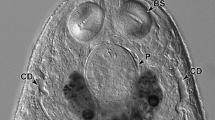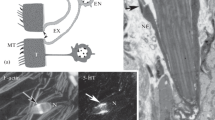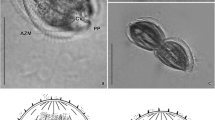Abstract
The fine structure of the excretory system in the juvenile (plerocercoid-like) form ofTrilocularia acanthiaevulgaris is described. The flame cell bears a bunch of 50–70 cilia, which are anchored in the cytoplasm by means of basal bodies possessing striated rootlets. All the cilia in the “flame” are aligned in the same direction. The flame and duct cells are connected by interdigitating ribs of cytoplasm separated by a fibrous sheet. Both internal and external leptotriches are also present. The lumen of the excretory ducts is intracellular in origin. The apical surface of the cytoplasm lining the duct is convoluted and its surface area is further amplified by means of microvilli. The fine structure of the excretory system in this primitive tapeworm is compared with that described for other parasitic and free-living flatworms.
Similar content being viewed by others
References
Bonsdorff C-H von, Telkka A (1966) The flagellar structure of the flame cell in fish tapeworm (Diphyllobothrium latum). Z Zellforsch 70:169–179
Erasmus DA (1957) Studies on phosphatase systems of cestodes: II. Studies onCysticercus tenuicollis andMoniezia expansa (adult). Parasitology 47:81–91
Howells RE (1969) Observations on the nephridial system of the cestodeMoniezia expansa (Rud., 1805). Parasitology 59:449–459
Lumsden RD, Hildreth MB (1983) The fine structure of adult tapeworms. In: Arme C, Pappas PW (eds) Biology of the Eucestoda, vol 1. Academic Press, London, pp 177–233
Lumsden RD, Specian R (1980) The morphology, histology and fine structure of the adult stage of the cyclophyllidean tapewormHymenolepis diminuta. In: Arai HP (ed) Biology of the tapewormHymenolepis diminuta. Academic Press, London. pp 157–280
McCullough JS, Fairweather I (1984) A compartive study ofTrilocularia acanthiaevulgaris Olsson 1867 (Cestoda, Tetraphyllidea) from the stomach and spiral valve of the spiny dogfish. Z Parasitenkd 70:797–807
Parshad VR, Guraya SS (1977) Comparative histochemical observations on the excretory system of helminth parasites. Z Parasitenkd 52:81–89
Rees G (1953) Some parasitic worms from fishes off the coast of Iceland: I. Cestoda. Parasitology 43:4–14
Rohde K (1973) Ultrastructure of the protonephridial system ofPolystomoides malayi Rohde andP. renschi Rohde (Monogenea: Polystomatidae). Int J Parasitol 3:329–333
Rohde K (1982) The flame cells of a monogenean and an aspidogastrean, not composed of two interdigitating cells. Zool Anz 209:311–314
Rohde K (1986) Ultrastructure of the flame cells and protonephridial capillaries ofTemnocephala: implications for the phylogeny of parasitic Platyhelminthes. Zool Anz 216:39–47
Rohde K (1988) Phylogenetic relationships of free-living and parasitic Platyhelminthes on the basis of ultrastructural evidence. Fortschr Zool 36:353–357
Rohde K, Georgi M (1983) Structure and development ofAustramphilina elongata Johnston, 1931 (Cestodaria: Amphilinidea). Int J Parasitol 13:273–287
Rohde K, Watson N, Roubal F (1989) Ultrastructure of the protonephridial system ofDactylogyrus sp. and an unidentified ancyrocephaline (Monogenea: Dactylogyridae). Int J Parasitol 19:859–864
Skuce PJ, Anderson HR, Faireather I (1987) The interaction between the deacetylated (amine) metabolite of diamphenethide (DAMD) and cytochemically demonstrable Na+/K+-ATPase activity in the tegument ofFasciola hepatica. Parasitol Res 74:161–167
Smyth JD, Halton DW (1983) The physiology of trematodes, 2nd edn. Cambridge University Press, Cambridge
Swiderski Z, Euzet L, Schönenberger N (1975) Ultrastructures du système néphridien des cestodes cyclophyllidesCatenotaenia pusilla (Goeze, 1782),Hymenolepis diminuta (Rudolphi, 1819) etInermicapsifer madagascariensis (Davaine, 1870) Boer, 1956. Cellule 71:7–18
Threadgold LT, Brennan G (1978)Fasciola hepatica: basal infolds and associated vacuoles of the tegument. Exp Parasitol 46:300–316
Xylander WER (1987) Ultrastructure of the lycophora larva ofGyrocotyle urna (Cestoda, Gyrocotylidea): III. The protonephridial system. Zoomorphology 107:88–95
Author information
Authors and Affiliations
Rights and permissions
About this article
Cite this article
McCullough, J.S., Fairweather, I. Ultrastructure of excretory system ofTrilocularia acanthiaevulgaris (Cestoda, Tetraphyllidea). Parasitol Res 77, 157–160 (1991). https://doi.org/10.1007/BF00935430
Accepted:
Issue Date:
DOI: https://doi.org/10.1007/BF00935430




